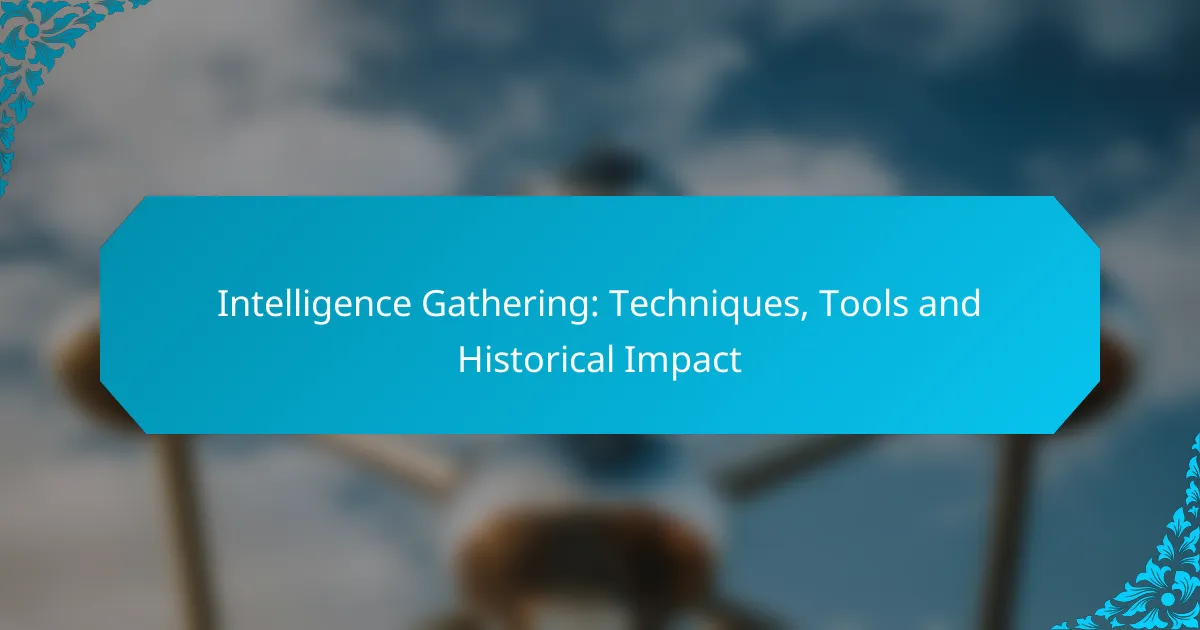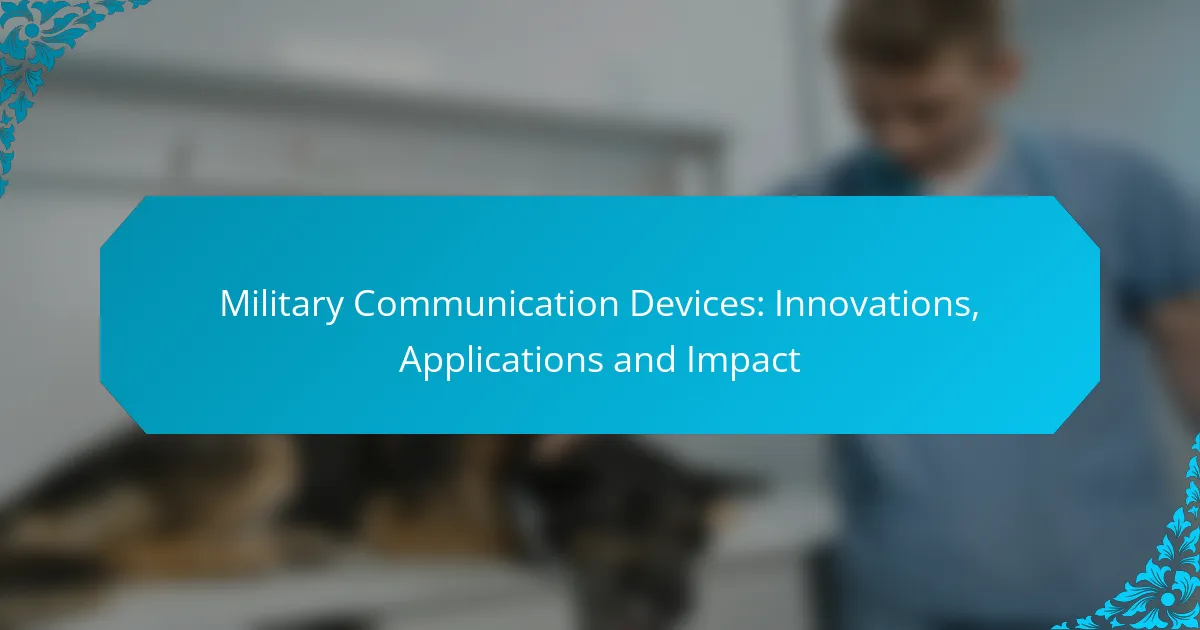Intelligence gathering encompasses a range of techniques designed to collect, analyze, and interpret information crucial for national security, business, and personal safety. Utilizing advanced tools and technologies, analysts can uncover patterns and assess risks, ultimately enhancing decision-making processes. The evolution of these methods reflects significant shifts in geopolitical dynamics and technological advancements, highlighting the growing importance of effective intelligence in our increasingly complex world.
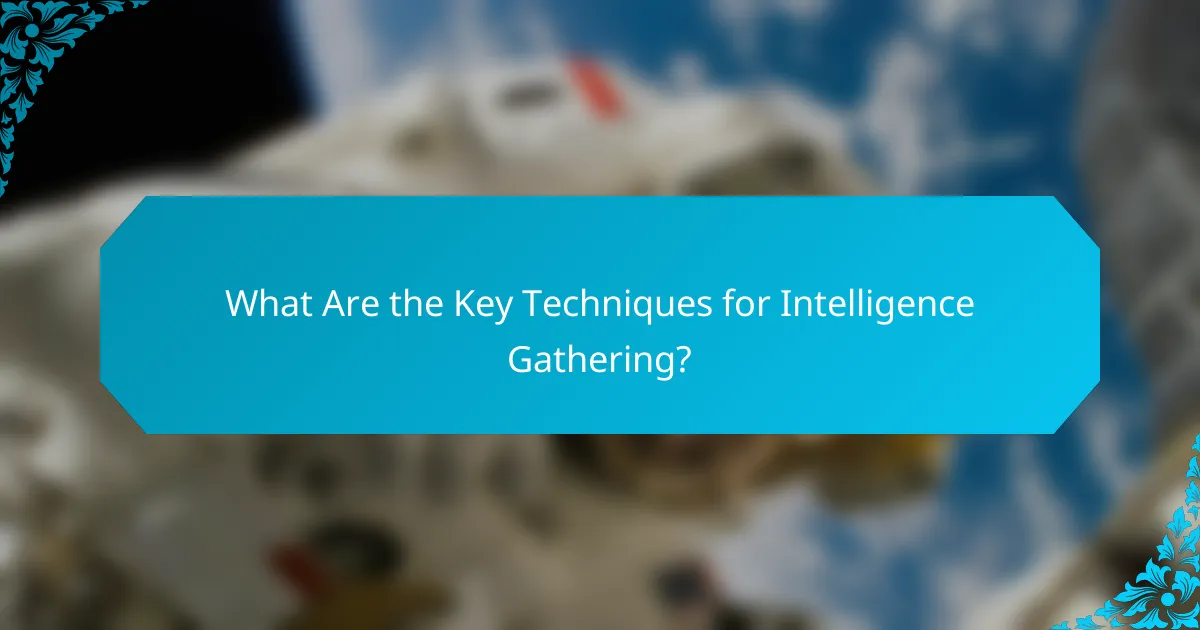
What Are the Key Techniques for Intelligence Gathering?
The key techniques for intelligence gathering include various methods that help collect, analyze, and interpret information relevant to national security, business, or personal safety. These techniques leverage different sources and technologies to provide insights that inform decision-making processes.
Open Source Intelligence (OSINT)
Open Source Intelligence (OSINT) involves collecting information from publicly available sources. This can include websites, social media, news articles, and government reports. OSINT is valuable because it is often low-cost and can provide a wealth of information without the need for covert operations.
When using OSINT, it’s crucial to verify the credibility of sources to avoid misinformation. Tools like search engines, social media monitoring platforms, and data aggregation services can enhance the efficiency of OSINT collection.
Human Intelligence (HUMINT)
Human Intelligence (HUMINT) is derived from interpersonal interactions and relationships. This technique often involves gathering information through interviews, espionage, or informants. HUMINT is particularly effective in understanding motivations and intentions that are not easily captured through technical means.
However, HUMINT can be resource-intensive and may involve ethical considerations, especially regarding privacy and consent. Building trust with sources is essential for successful HUMINT operations.
Signals Intelligence (SIGINT)
Signals Intelligence (SIGINT) focuses on intercepting and analyzing electronic communications. This includes phone calls, emails, and other forms of digital communication. SIGINT is critical for monitoring potential threats and understanding adversary capabilities.
Organizations must adhere to legal regulations when conducting SIGINT to ensure compliance with privacy laws. Effective SIGINT operations often require sophisticated technology and skilled analysts to interpret the data accurately.
Geospatial Intelligence (GEOINT)
Geospatial Intelligence (GEOINT) involves the analysis of imagery and geospatial information to understand physical locations and environments. This technique uses satellite images, maps, and geographic information systems (GIS) to provide context for intelligence operations.
GEOINT is particularly useful for military operations, disaster response, and urban planning. Analysts must be proficient in interpreting spatial data and understanding the implications of geographic factors on security issues.
Measurement and Signature Intelligence (MASINT)
Measurement and Signature Intelligence (MASINT) refers to the collection and analysis of data from various sensors to detect and characterize phenomena. This can include radar, infrared, and acoustic sensors, providing insights into activities that may not be visible through traditional intelligence methods.
MASINT is often used in conjunction with other intelligence types to enhance situational awareness. However, it requires specialized equipment and expertise to analyze the complex data generated by these sensors effectively.
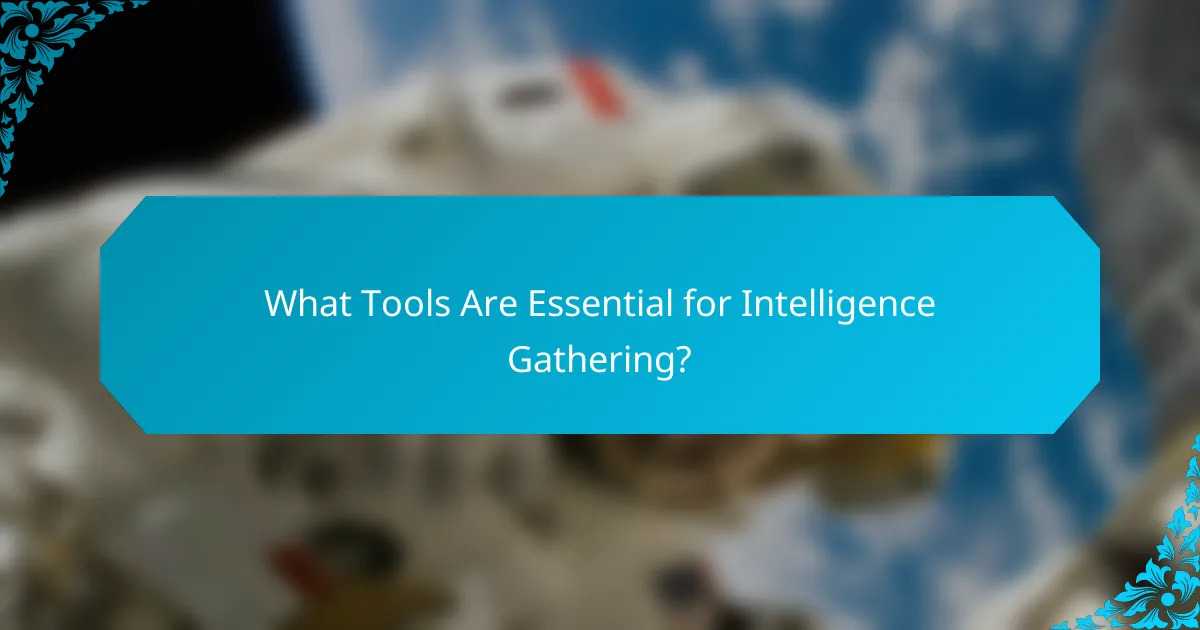
What Tools Are Essential for Intelligence Gathering?
Essential tools for intelligence gathering include software and platforms that facilitate data collection, analysis, and visualization. These tools help analysts uncover patterns, assess risks, and make informed decisions based on comprehensive information.
Maltego
Maltego is a powerful tool for open-source intelligence (OSINT) that allows users to visualize relationships between various entities, such as people, organizations, and domains. It utilizes a graph-based interface to represent data connections, making it easier to identify patterns and insights.
When using Maltego, consider the types of transforms available, which can include DNS queries, social media searches, and more. This versatility enables users to adapt their investigations based on specific intelligence needs.
Shodan
Shodan is a search engine that indexes devices connected to the internet, providing insights into their vulnerabilities and configurations. It is particularly useful for cybersecurity professionals who need to assess the security posture of devices like servers, routers, and IoT devices.
To effectively use Shodan, familiarize yourself with its search filters and capabilities. For instance, you can search by device type, geographical location, or specific vulnerabilities, allowing for targeted intelligence gathering.
Social-Engineer Toolkit (SET)
The Social-Engineer Toolkit (SET) is designed for penetration testing and social engineering assessments. It helps security professionals simulate real-world attacks to identify vulnerabilities in human behavior and organizational processes.
When using SET, focus on its various attack vectors, such as phishing campaigns and credential harvesting. Understanding these methods can enhance your ability to prepare defenses against social engineering threats.
Palantir Technologies
Palantir Technologies offers advanced data integration and analysis tools that are widely used in government and commercial sectors. Its platforms enable users to analyze large datasets, uncover hidden connections, and support decision-making processes.
Utilizing Palantir requires a solid understanding of data management and analysis techniques. Organizations should ensure they have the necessary infrastructure and training to maximize the tool’s capabilities for intelligence gathering.
IBM i2 Analyst’s Notebook
IBM i2 Analyst’s Notebook is a visual analysis tool that helps users organize and analyze complex data sets. It is particularly effective for law enforcement and intelligence agencies in identifying relationships and patterns in criminal or suspicious activities.
To get the most out of IBM i2, leverage its charting capabilities and link analysis features. This can aid in visualizing connections that may not be immediately apparent, enhancing the overall intelligence analysis process.
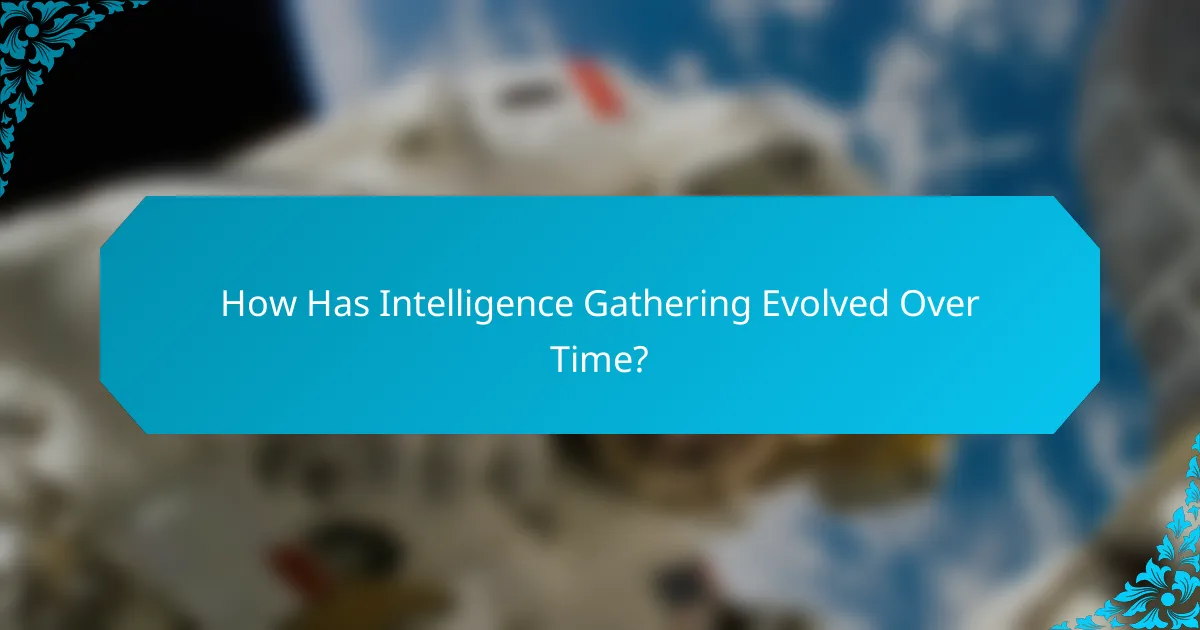
How Has Intelligence Gathering Evolved Over Time?
Intelligence gathering has significantly transformed from rudimentary methods to sophisticated technologies and strategies. This evolution reflects changes in geopolitical dynamics, technological advancements, and societal expectations regarding privacy and security.
Historical Milestones
The history of intelligence gathering can be traced back to ancient civilizations, where information was often collected through spies and informants. Key milestones include the establishment of formal intelligence agencies in the 20th century, such as the CIA in the United States and MI6 in the United Kingdom, which marked a shift towards organized and systematic intelligence operations.
World War II was another pivotal moment, as it saw the use of cryptography and signals intelligence on an unprecedented scale. The development of the Enigma machine and its subsequent decryption by Allied forces exemplifies how intelligence can alter the course of history.
Technological Advancements
Technological advancements have revolutionized intelligence gathering, enabling faster and more accurate data collection. The introduction of satellite surveillance and drones has expanded the scope of reconnaissance, allowing agencies to monitor vast areas without physical presence.
Additionally, advancements in data analytics and artificial intelligence have enhanced the ability to process and interpret large volumes of information. These technologies enable analysts to identify patterns and predict potential threats more effectively.
Impact of the Internet
The internet has dramatically changed the landscape of intelligence gathering by providing access to vast amounts of publicly available information. Open-source intelligence (OSINT) has become a critical component, allowing agencies to gather insights from social media, blogs, and news articles.
However, the internet also presents challenges, such as the proliferation of misinformation and the difficulty in verifying sources. Intelligence agencies must develop strategies to discern credible information from false narratives in this digital age.
Changes in Legislation
Legislation surrounding intelligence gathering has evolved to address privacy concerns and civil liberties. Laws such as the USA PATRIOT Act expanded surveillance capabilities in the wake of 9/11, while also sparking debates over the balance between security and individual rights.
In recent years, many countries have enacted stricter regulations to ensure transparency and accountability in intelligence operations. These changes often reflect public sentiment and the need for oversight in intelligence activities.
Case Studies of Major Events
Case studies such as the 9/11 attacks and the Russian interference in the 2016 U.S. elections highlight the importance of effective intelligence gathering. In the case of 9/11, failures in information sharing among agencies underscored the need for improved coordination and communication.
Conversely, the use of intelligence in counter-terrorism operations has demonstrated the effectiveness of timely and accurate information. Lessons learned from these events continue to shape current intelligence practices and policies.
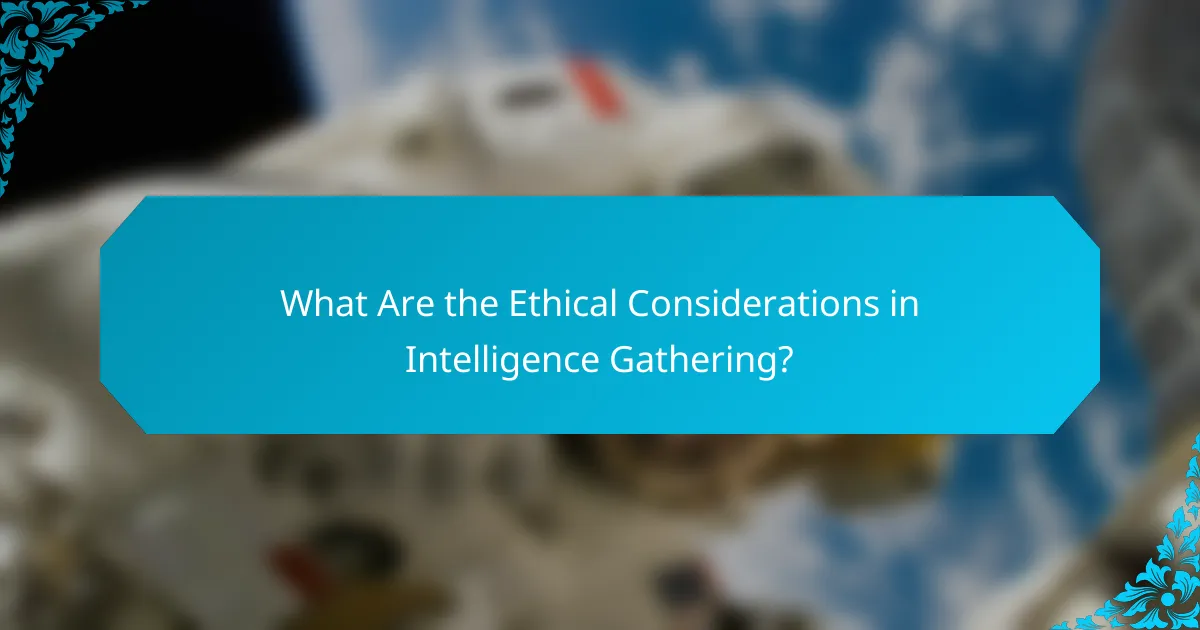
What Are the Ethical Considerations in Intelligence Gathering?
Ethical considerations in intelligence gathering revolve around balancing national security needs with individual rights. Key issues include privacy, legality, accountability, and public trust, which can significantly impact the effectiveness and legitimacy of intelligence operations.
Privacy Concerns
Privacy concerns are paramount in intelligence gathering, as intrusive methods can violate individual rights. Surveillance techniques, such as wiretapping or data mining, often raise questions about the extent to which personal information can be collected without consent.
To mitigate privacy risks, intelligence agencies should implement strict protocols that limit data collection to what is necessary for security purposes. Transparency about data usage can also help maintain public trust.
Legal Frameworks
Legal frameworks govern the boundaries of intelligence gathering, ensuring that operations comply with national and international laws. In many countries, laws like the USA PATRIOT Act in the United States or the General Data Protection Regulation (GDPR) in the European Union set specific guidelines for data collection and surveillance.
Agencies must regularly review and update their practices to align with evolving legal standards, which can vary significantly by jurisdiction. Understanding these frameworks is crucial for ethical compliance.
Accountability Measures
Accountability measures are essential to ensure that intelligence activities are conducted ethically and responsibly. Oversight bodies, such as parliamentary committees or independent watchdogs, can help monitor intelligence operations and address any abuses of power.
Establishing clear reporting mechanisms and consequences for unethical behavior is vital. Regular audits and assessments can also enhance accountability and public confidence in intelligence practices.
Public Perception
Public perception plays a critical role in the legitimacy of intelligence gathering efforts. If citizens feel that their privacy is being compromised or that intelligence agencies operate without oversight, trust in these institutions can diminish.
Engaging with the public through education and transparency initiatives can help improve understanding of the necessity of intelligence work. Open dialogues about ethical practices can foster a more informed and supportive environment for intelligence operations.
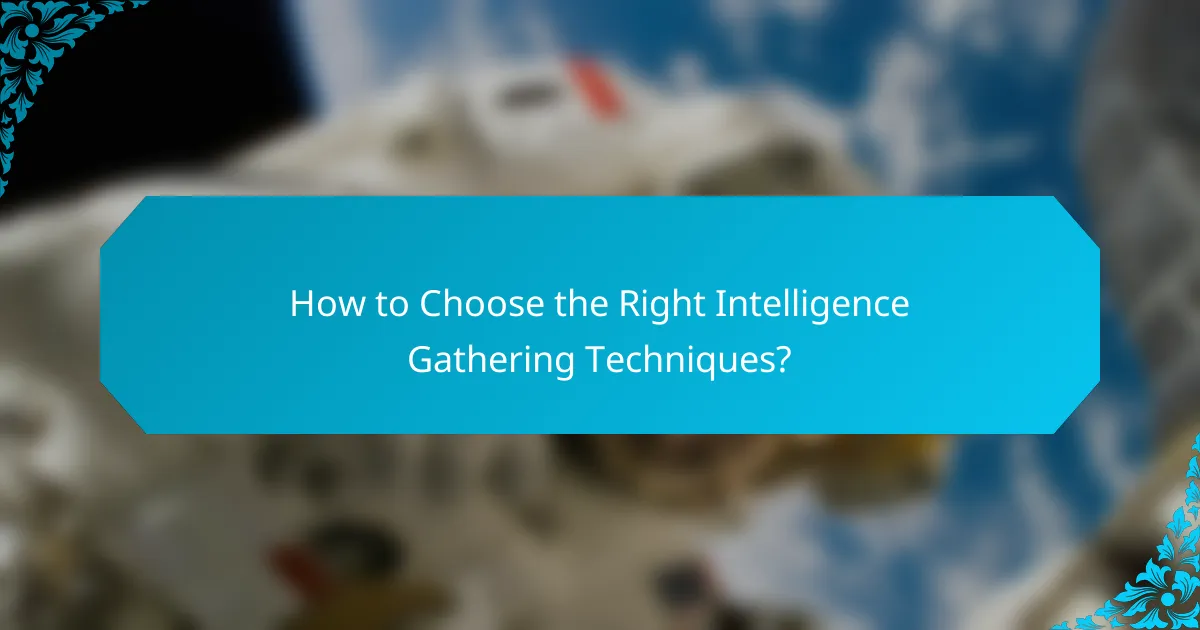
How to Choose the Right Intelligence Gathering Techniques?
Selecting the appropriate intelligence gathering techniques involves understanding your objectives, available resources, and the context of the information needed. Consider the specific goals of your intelligence efforts, the tools at your disposal, and the legal or ethical implications associated with each method.
Consider Your Objectives
Your objectives will dictate the intelligence gathering techniques you should employ. Clearly define what information you need and why, as this will help you prioritize methods that align with your goals. For instance, if you’re looking for competitive analysis, open-source intelligence (OSINT) may be more suitable than human intelligence (HUMINT).
Evaluate Available Resources
Assess the resources you have, including time, budget, and personnel. Some techniques, like surveillance or in-depth interviews, may require significant investment in terms of both money and manpower. In contrast, methods such as online research can be less resource-intensive and quicker to implement.
Understand Legal and Ethical Implications
Be aware of the legal and ethical considerations surrounding intelligence gathering. Different countries have varying regulations regarding privacy and data collection. For example, in the EU, the General Data Protection Regulation (GDPR) imposes strict rules on how personal data can be collected and used. Always ensure compliance to avoid legal repercussions.
Assess the Reliability of Sources
The reliability of your sources is crucial for the accuracy of the intelligence gathered. Evaluate the credibility of the information and the trustworthiness of the sources. Cross-checking data from multiple sources can enhance reliability. For example, corroborating information from industry reports with insights from experts can provide a more comprehensive view.
Choose Techniques Based on Context
The context in which you are operating will influence your choice of techniques. In a fast-paced business environment, real-time data collection methods like social media monitoring may be essential. Conversely, in a more stable context, traditional methods such as archival research may suffice. Tailor your approach to fit the specific circumstances you face.
